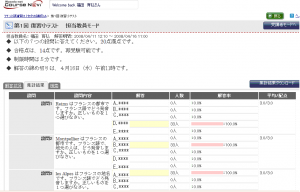03-01. Course N@vi Can Make Fine-Tuned Instruction Much More Efficient
Ikuhiro Fukuda
Professor, Faculty of Education and Integrated Arts and Sciences
“Practice by repetition is absolutely essential to language studies” is the policy of Professor Fukuda, who has years of hands-on experience in providing students with focused instruction to develop their abilities and skills in all sorts of class settings, from large lectures to intimate seminars, on languages and other subjects as well. According to Professor Fukuda, the introduction of Course N@vi to the teaching frontlines has greatly reduced faculty members’ labor and elevated learning outcomes.
Foreign languages: The detailed grading system allows for assessments of day-to-day effort
In a French language seminar, for instance, Professor Fukuda uses Course N@vi in the following way. Prior to the seminar, he has all students translate the text that will be used in the class and submit their translations using Course N@vi’s report function. Professor Fukuda grades the students’ work on Course N@vi and returns the translations to the students for them to print out and check their mistakes. In the class, he focuses on explaining the areas where the students had the most trouble. After the class, he has the students write in questions about the class and give their impressions and comments with Course N@vi’s discussion function. A few days later, he assigns a short test with the quiz function to confirm their understanding of the material. By going through this cycle of pre-class assignments, impressions, and quizzes for each class, Professor Fukuda guides his students so they definitely add to their abilities each class.
“Holding just one end-of-term examination is pointless in language studies: Practice by repetition is absolutely essential. Only by gradually building on each tutorial, can you be sure to develop competence in a language.”
Acting from this conviction, Professor Fukuda has always provided this kind of fine-tuned instruction, but the appearance of Course N@vi has made his job a lot easier.
For example, the professor used to send out assignments by email, but with email, assignments were still accepted even after the deadline. With Course N@vi’s deadline function, however, once a deadline has passed, assignments are automatically rejected. In other words, faculty members have much stricter control over the time period for submissions.
Another breakthrough is Course N@vi’s automatic tabulation of grades. “When I had students send in their impressions and assignments by email, it was still a big task because I had to manually tabulate their grades. It’s much easier now with Course N@vi because all I do is enter the individual marks online and the system does the calculations automatically.”
Professor Fukuda uses a multiple-choice format for his post-class quizzes. “The multiple-choice format is simpler because the system can automatically mark the quizzes. It does take some time to think of erroneous and misleading answers for the quizzes, but once the quizzes are made, they can be used each year with just some slight modifications. Over the long term, these quizzes can save a tremendous amount of time and energy.”
Although he sets a time limit for the students to answer the quizzes, he lets them retry the quizzes as many times as they like. “Ultimately, what is important is that they understand the material, so I let them try over and over until they can post their best mark. I can check the log to see how many times they’ve taken the quiz. Some students have repeated the same quiz more than 50 times.”
Setting quizzes on Course N@vi has another benefit. “Because I can see right away the percentage of correct answers for each question, I know how well they understand the material in general and where specifically they are having problems.”
Although the final examination is conducted in a classroom, it counts for only 400 points of the total 1,500 points or so for a course. The remaining points come from marks given to assignments, class impressions, quizzes, and other coursework recorded on Course N@vi. Accumulating points for each piece of coursework not only rewards students for their day-to-day studies, it helps faculty members eliminate any unfairness due to subjective opinions. “In small classes, it is hard not to be swayed by your own emotional subjective opinions. Using this detailed numerical system, however, leads to much fairer student assessments. Many times I’ve discovered that someone who looks like a slacker is actually quite a serious student.”
Large classes: Encourage student participation through pre-class questionnaires and class reviews
Professor Fukuda uses the quiz function for other applications as well.
In a survey course like Architecture of Cultural Sciences 1, which first-year students take as an elective or required subject, there can be more than 150 students. Professor Fukuda uses the quiz function to give students a brief questionnaire about the upcoming topic. The questionnaire piques the students’ interest in the next lecture while providing the faculty member with a good understanding of the students’ viewpoints prior to the lecture. The quiz function is used so that marks can be given to students who participate in the questionnaire. And pasting the compiled results in a PowerPoint presentation and showing them to the students in class gets the students more interested in listening to the lecture.
After class, the professor makes use of the quiz function again to have students provide their impressions and ask questions about the class. Doing so also earns students marks. The professor also strives to reply to as many comments as possible. “Students believe that university classes are one-way only, but when they receive a response from a professor, they seem to be pleased to know that their comments have been read. I try to answer about a third of the students’ comments no matter how busy I am, particularly for introductory classes, to maintain their motivation after entering the university.”
There will always be a distance between the professor and the students in large classes, but Course N@vi can serve as a tool that addresses students’ desire for more communication with their professors.
Seminars: Practicing presentation and commenting skills using the discussion function
On the other hand, Professor Fukuda makes use of the discussion function for seminar courses with few students.
For example, Thematic Seminars in Cultural Sciences 1 — Representations of Eating and Drinking in Film, a seminar course for first-year students, has only 24 students. The seminars proceed with students giving presentations in turn on a given film. Professor Fukuda requires all students to write, using the discussion function, their impressions of the next film prior to the seminar. This not only raises the interest level of all students in the presentations; it also allows the presenters to look at other students’ opinions and tweak their presentation beforehand.
And although discussions are held in the classroom after presentations, the professor also has the students write their impressions on Course N@vi after class. “Often the debate just starts getting heated when we run out of time in the classroom. By taking a pause and having the students write in their opinions again leads to a more fruitful debate. And for students who didn’t get a chance to speak in class, the discussion BBS is great because they can post their opinions after collecting their thoughts. I believe more opinions end up being expressed in the BBS than in classroom discussions.”
The discussion function also allows each student to learn the strengths and weaknesses of their presentations. The discussions often lead them to discover problems they hadn’t noticed, which is useful in the future when writing their graduation thesis. Furthermore, students’ commenting skills definitely develop by repeating this sort of posting work routinely.
For discussions in third and fourth year seminars, the professor sometimes deliberately uses an external BBS system that is not part of Course N@vi. The reason for this is to publicize the content of the seminars to people not taking the seminar. IDs and passwords are used so that only seminar students can post on the BBS and to protect against trolling. “Showing what topics are being discussed in the seminar gives other students, especially new students and second-year students, a reference for selecting seminars.”
Posting on these BBS also earns seminar students marks, but because the system is not part of Course N@vi, the professor still has to manually add in these statistics with the other marks. “It would be fantastic if Course N@vi had a mechanism that let non-course students access and browse content.”
The problem is students who don’t access Course N@vi
On the whole, Course N@vi is popular among students because their day-to-day efforts are recognized, the grading schemes are clear, and it opens up communications with faculty members.
At the same time, there are some students who find the obligation to access Course N@vi onerous. “I understand it’s a bother to take the time after class to access Course N@vi from a computer, not to do some detailed assignment, but just to leave brief impressions on a class. With attendance cards, you could jot down your feelings in class and be done with it. It seems that at present only a few faculty members have introduced Course N@vi in their courses, but I think the situation will change once a majority of faculty members start using Course N@vi. When accessing Course N@vi from a computer becomes a given for students, you will certainly see a shift in the students’ mentality.”
Course N@vi does not currently support mobile-phone access. Although there are arguments both for and against allowing mobile-phone access, Professor Fukuda is in the pro camp. “There is the aspect that people do tend to write shorter sentences and that sentence structure tends to suffer when posting from mobile devices. But if it’s easier for students to access Course N@vi from mobile devices, then that’s fine by me. I think Course N@vi really deserves to be used because it’s a tool for running classes that students find straightforward.”
Tips on implementing Course N@vi
“If you have students write class reviews on attendance cards in class, why not try transferring it to Course N@vi? Not only is managing student reviews easier, it facilitates two-way communication because you can make quick replies.”
<quiz window>
Quiz scores are added up automatically and presented to the students in real time. Quizzes can also be configured so that all students in the course can see everyone’s open-ended answers (for example, questions or opinions)



